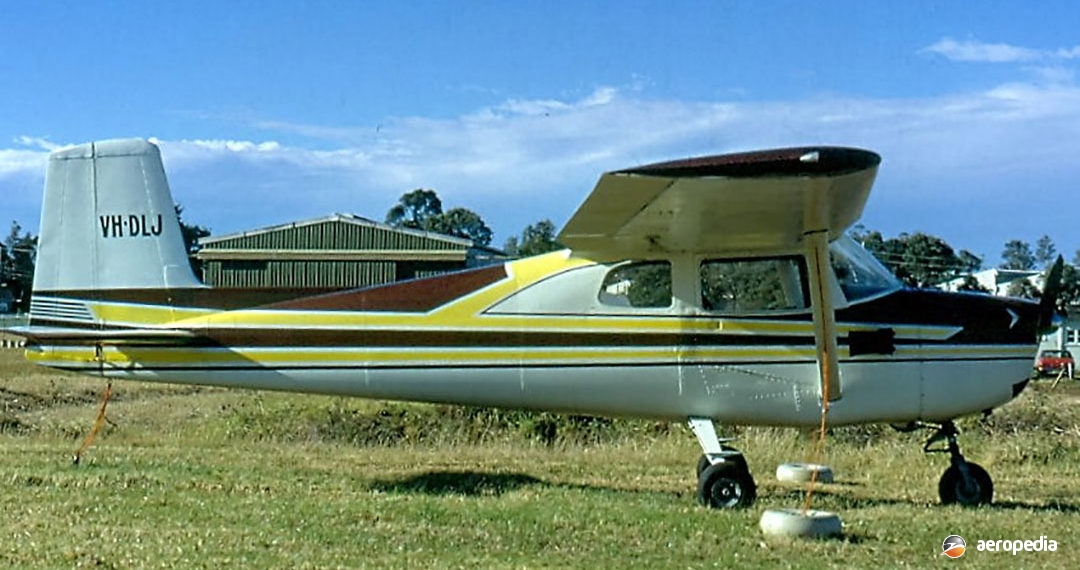Photograph:
Cessna 150A VH-DLJ (c/n 59087) at Cooma, NSW in July 1978 (David C Eyre)
Country of origin:
United States of America
Description:
Two-seat light training monoplane
Power Plant:
One 75 kw (100 hp) Continental O-200A four-cylinder horizontally-opposed air-cooled engine
Specifications:
- Wingspan: 10.2 m (33 ft 4 in)
- Length: 7.3 m (24 ft 9 in)
- Height: 2.6 m (8 ft 6 in)
- Wing area: 15 m² (161 sq ft)
- Max never exceed speed: 259 km/h (162 mph)
- Cruising speed: 198 km/h (123 mph)
- Stalling speed: 78 km/h (48 mph)
- Service ceiling: 4,300 m (14,000 ft)
- Rate of climb: 204 m/min (670 ft/min)
- Range: 678 km (421 miles)
- Empty weight: 504 kg (1,111 lb)
- Useful load: 220 kg (490 lb)
- Loaded weight: 730 kg (1,600 lb)
History:
Designed as a successor to the Cessna Models 120 and 140, production of which concluded in the mid 1950s, the Cessna 150 series proved to be one of the most popular civil training aircraft, with some 22,839 examples constructed and delivered between 1959 and 1977. The prototype, known originally as the Model 142, first flew on 12 September 1957 at the Company’s Wichita, Kansas plant and it mainly differed from the Model 140 in having a tricycle undercarriage. Following certification, production commenced almost twelve months later in September 1958.
The Model 150 was licence-built in France by Reims Aviation, being designated F-150 and being fitted with a 97 kw (130 hp) Rolls Royce O-240-A engine. Some 22,138 were built in the United States, consisting of 21,404 Commuters and 734 Aerobats; and Reims built 1,764 of which 1,428 were Commuters and 336 Aerobats. A Reims affiliate in Argentina assembled 47 from the French production line for the local market.
When production commenced in 1958 the aircraft was available as the Model 150 or the upgraded Commuter and had a gross weight of 680 kg (1,500 lb), the flaps being activated by a lever between the seats. In 1960 a new model was introduced as the Patroller with long-range fuel tanks, a message chute and glass in the lower doors. The 1961 model was the 150A and had larger windows, the main undercarriage being moved aft, and 344 were completed. In 1962 the Model 150B had a new propeller and an optional child seat, 331 being delivered. The Model 150C was introduced in 1963 and had optional larger tyres, 472 being delivered. The Model 150D in 1964 introduced the “Omni-vision” rear window, a larger baggage area and other changes, gross weight being increased to 730 kg (1,600 lb), 804 being completed.
The 1965 Model 150E had new seats designed and 1,637 were delivered. The Model 150F in 1966 had the fin swept back, the cabin doors enlarged, new brakes and wheels, and electrically-operated flaps, 3,087 being built. The Model 150G in 1967 had the cabin enlarged and was certified for floats, 2,114 being built. The Model 150H in 1968 had improved legroom and other minor changes, 2007 being built in Wichita and 170 in France.
The next model was the 150J with a key-operated starter, 1714 being built in Wichita and 140 in France. The Model 150K included the Aerobat with limited aerobatic capability, this model having increased structural strength. A total of 832 was built in Wichita and in France it was built as the Models A150K and F150K, 210 being delivered. In 1970, with the Model 150K model, production was transferred from the Strotherfield facility to the Pawnee plant.
Over the years the Model 150 was produced in three basic versions: Standard, Trainer and Commuter. Each varied mainly with the amount of equipment installed as standard. The Model A150K was introduced designed for limited aerobatics, it was known as the Aerobat, and continued in production alongside the standard Commuter model.
The Model 150L was produced from 1971 to 1974, had new undercarriage legs and other minor changes, the landing lights being relocated from the wings to the nose. A total of 4,519 were built in the US and 524 in France.
Last model built was introduced in 1975 as the 150M and was produced for three years. A number of refinements were introduced during its production life including increased gross weight. A total of 3,097 was built in the US and 426 in France as the Models F150M and FA150M, and 75 Model A150Ls which had Model F150M modifications.
At least one example of the Cessna 150 has been placed on the RAA register in Australia. Described as a High Wing Raven, it became 19-7055 and was fitted with a Continental O-200A engine.+
Further refinement led to the Model 151 and, eventually, in 1978, to the Model 152. Reims Aviation built the Model F152. These differed from earlier models in the series by having an 82 kw (110 hp) Lycoming O-235 engine designed to use 100 octane fuel and a McCauley ‘gull-wing’ propeller, a re-designed spinner, re-designed fuel tanks that reduced the quantity of unused fuel, a 28 volt electrical system, and a one-piece cowling. The Model 152 Aerobat was stressed for +6/-3 G manoeuvres and was certified for barrel rolls, spins, loops, Immelmanns, vertical reversements, aileron rolls, Cuban eights, and snap rolls.
More than 100 have appeared on the New Zealand register and more than 350 have appeared on the Australian register.

